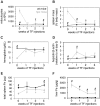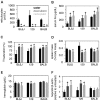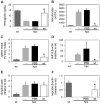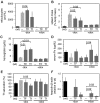Transferrin is a major determinant of hepcidin expression in hypotransferrinemic mice
- PMID: 20956801
- PMCID: PMC3031485
- DOI: 10.1182/blood-2010-05-287359
Transferrin is a major determinant of hepcidin expression in hypotransferrinemic mice
Abstract
As a central regulator of iron metabolism, hepcidin inhibits dietary iron absorption and macrophage iron recycling. Its expression is regulated by multiple factors including iron availability and erythropoietic activity. To investigate the role of transferrin (Tf) in the regulation of hepcidin expression by these factors in vivo, we employed the hypotransferrinemic (hpx) mouse. These Tf-deficient mice have severe microcytic anemia, tissue iron overload, and hepcidin deficiency. To determine the relationship of Tf levels and erythropoiesis to hepcidin expression, we subjected hpx mutant and control mice to a number of experimental manipulations. Treatment of hpx mice with Tf injections corrected their anemia and restored hepcidin expression. To investigate the effect of erythropoiesis on hepcidin expression, we suppressed erythropoiesis with blood transfusions or myeloablation with chemotherapeutic drugs. Transfusion of hpx animals with wild-type red blood cells led to increased hepcidin expression, while hepcidin expression in myeloablated hpx mice increased only if Tf was administered postablation. These results suggest that hepcidin expression in hpx mice is regulated both by Tf-restricted erythropoiesis and by Tf through a mechanism independent of its role in erythropoiesis.
Figures







Similar articles
-
Hemojuvelin is essential for transferrin-dependent and transferrin-independent hepcidin expression in mice.Haematologica. 2012 Feb;97(2):189-92. doi: 10.3324/haematol.2011.054031. Epub 2011 Oct 11. Haematologica. 2012. PMID: 21993681 Free PMC article.
-
Known and potential roles of transferrin in iron biology.Biometals. 2012 Aug;25(4):677-86. doi: 10.1007/s10534-012-9520-3. Biometals. 2012. PMID: 22294463 Free PMC article. Review.
-
The transferrin receptor modulates Hfe-dependent regulation of hepcidin expression.Cell Metab. 2008 Mar;7(3):205-14. doi: 10.1016/j.cmet.2007.11.016. Cell Metab. 2008. PMID: 18316026 Free PMC article.
-
Liver iron concentrations and urinary hepcidin in beta-thalassemia.Haematologica. 2007 May;92(5):583-8. doi: 10.3324/haematol.10842. Haematologica. 2007. PMID: 17488680
-
Hepcidin and disorders of iron metabolism.Annu Rev Med. 2011;62:347-60. doi: 10.1146/annurev-med-050109-142444. Annu Rev Med. 2011. PMID: 20887198 Review.
Cited by
-
Increasing serum transferrin to reduce tissue iron overload due to ineffective erythropoiesis.Haematologica. 2015 May;100(5):565-6. doi: 10.3324/haematol.2015.124966. Haematologica. 2015. PMID: 25944634 Free PMC article. No abstract available.
-
Zebrafish in the sea of mineral (iron, zinc, and copper) metabolism.Front Pharmacol. 2014 Mar 6;5:33. doi: 10.3389/fphar.2014.00033. eCollection 2014. Front Pharmacol. 2014. PMID: 24639652 Free PMC article. Review.
-
Iron metabolism and its association with dyslipidemia risk in children and adolescents: a cross-sectional study.Lipids Health Dis. 2019 Feb 12;18(1):50. doi: 10.1186/s12944-019-0985-8. Lipids Health Dis. 2019. PMID: 30755213 Free PMC article.
-
Severe Iron Metabolism Defects in Mice With Double Knockout of the Multicopper Ferroxidases Hephaestin and Ceruloplasmin.Cell Mol Gastroenterol Hepatol. 2018 Jun 23;6(4):405-427. doi: 10.1016/j.jcmgh.2018.06.006. eCollection 2018. Cell Mol Gastroenterol Hepatol. 2018. PMID: 30182051 Free PMC article.
-
Hemojuvelin is essential for transferrin-dependent and transferrin-independent hepcidin expression in mice.Haematologica. 2012 Feb;97(2):189-92. doi: 10.3324/haematol.2011.054031. Epub 2011 Oct 11. Haematologica. 2012. PMID: 21993681 Free PMC article.
References
-
- Fleming MD. The regulation of hepcidin and its effects on systemic and cellular iron metabolism. Hematology Am Soc Hematol Educ Program. 2008:151–158. - PubMed
-
- Trenor CC, Campagna DR, Sellers VM, Andrews NC, Fleming MD. The molecular defect in hypotransferrinemic mice. Blood. 2000;96(3):1113–1118. - PubMed
-
- Weinstein DA, Roy CN, Fleming MD, et al. Inappropriate expression of hepcidin is associated with iron refractory anemia: implications for the anemia of chronic disease. Blood. 2002;100(10):3776–3781. - PubMed
-
- Li H, Rybicki AC, Suzuka SM, et al. Transferrin therapy ameliorates disease in beta-thalassemic mice. Nat Med. 2010;16(2):177–182. - PubMed
Publication types
MeSH terms
Substances
Grants and funding
LinkOut - more resources
Full Text Sources
Medical
Molecular Biology Databases
Research Materials
Miscellaneous

